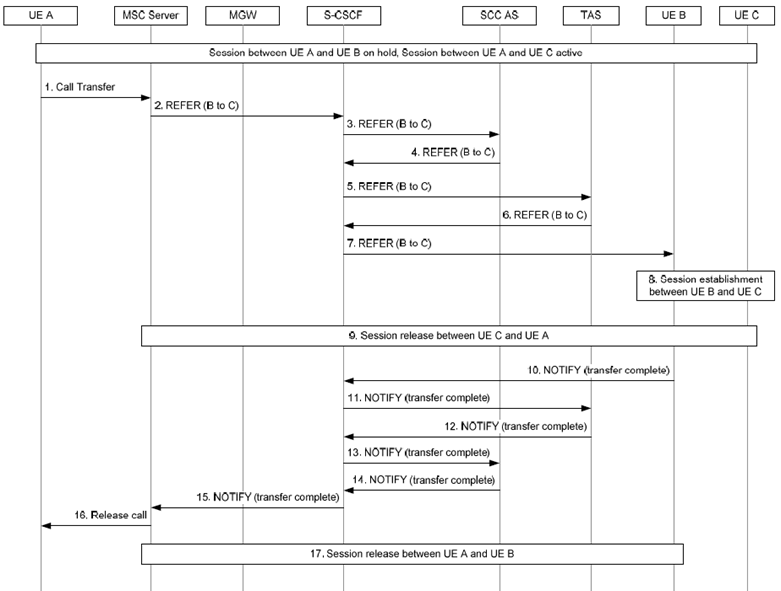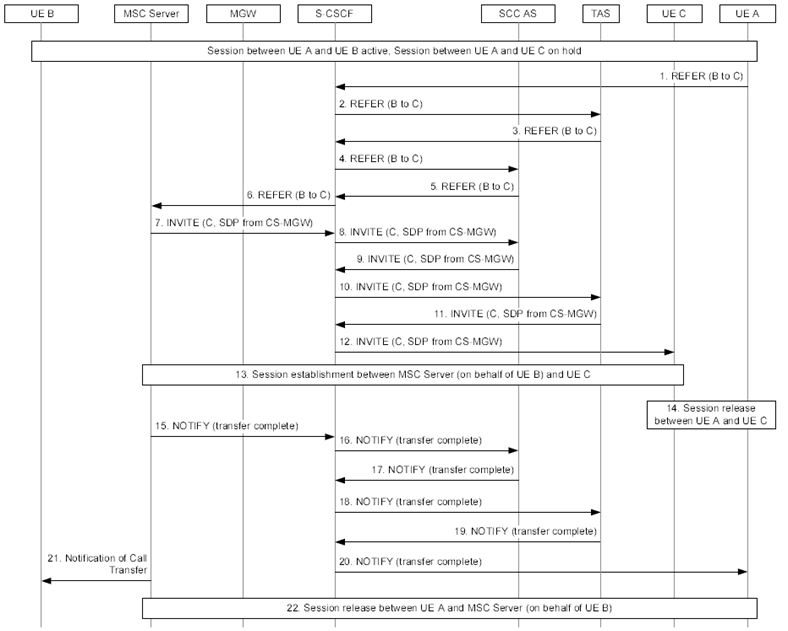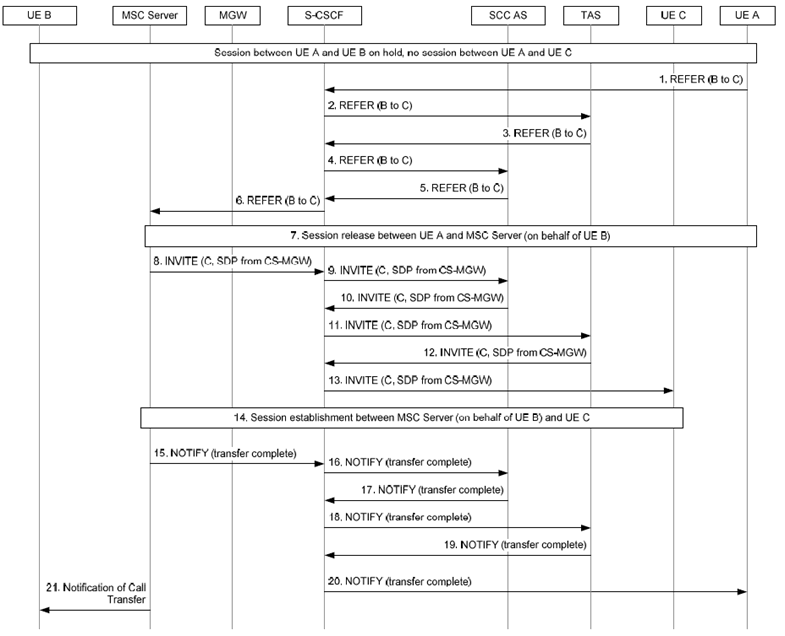Content for TS 23.292 Word version: 18.0.0
1…
4…
5…
7…
7.2…
7.3…
7.3.2.2…
7.3.2.2.4…
7.4…
7.4.2.2…
7.4.2.2.3…
7.4.2.2.7…
7.5…
7.6…
7.6.1.2.2.6…
7.6.1.2.3…
7.6.1.2.3.5…
7.6.1.2.3.6…
7.6.2…
7.6.2.7
7.6.2.8…
7.6.2.11…
7.6.3…
7.7…
7.7.2…
7.9…
7.9.2…
7.9.2.4
7.9.2.5
8…
A…
G…
H…
H.5…
H.5.3…
7.6.2.7 Explicit Communication Transfer p. 85
For IMS sessions established by UEs using CS media, the MSC Server enhanced for ICS shall perform the necessary interworking between the I2 reference point and CS signalling (e.g. as described in TS 24.091) to allow Explicit Communication Transfer (ECT) to be controlled by the IMS.
When the UE initiates ECT via CS access, the MSC Server enhanced for ICS shall support consultative transfer and shall play the initiator role as described in TS 23.228 on behalf of the UE. The MSC Server enhanced for ICS shall also support the recipient and target roles on behalf of the UE for consultative transfer as described in TS 23.228.
The MSC Server enhanced for ICS shall support the recipient and target roles on behalf of the UE for blind transfer as described in TS 23.228.
The MSC Server enhanced for ICS shall support the recipient and target roles on behalf of the UE for assured transfer as described in TS 23.228.
Figure 7.6.2.7-1 describes how IMS consultative ECT is performed via CS access, with the MSC Server enhanced for ICS playing the role of transfer initiator on behalf of the UE.

Figure 7.6.2.7-1: IMS Consultative ECT via MSC Server enhanced for ICS (transfer initiator)
(⇒ copy of original 3GPP image)
(⇒ copy of original 3GPP image)
Step 1.
Figure 7.6.2.7-2 describes how IMS consultative ECT is performed via CS access, with the MSC Server enhanced for ICS playing the role of transfer recipient on behalf of the UE.
UE A initiates transfer of UE B to UE C by sending a call transfer message (e.g. as specified in TS 24.091).
Step 2.
The MSC Server sends a REFER to the S-CSCF. The REFER indicates that UE B is to be transferred to UE C and that this new session is to replace the current session between UE A and UE B.
Step 3.
The S-CSCF sends the REFER to the SCC AS as it was inserted at session establishment.
Step 4.
The SCC AS sends the REFER to the S-CSCF.
Step 5.
The S-CSCF sends the REFER to the TAS for service execution.
Step 6.
The TAS sends the REFER to the S-CSCF.
Step 7.
The REFER is sent to UE B as the transfer recipient.
Step 8.
UE B initiates session establishment with UE C as specified in TS 24.173.
Step 9.
UE C initiates session release with UE A as specified in TS 24.173.
Step 10.
UE B provides indication that the communication transfer is complete as specified in TS 24.173.
Step 11.
The S-CSCF sends the NOTIFY to the TAS.
Step 12.
The TAS sends the NOTIFY to the S-CSCF.
Step 13.
The S-CSCF sends the NOTIFY to the SCC AS as it was inserted at session establishment.
Step 14.
The SCC AS sends the NOTIFY to the S-CSCF.
Step 15.
The MSC Server, as transfer initiator, receives notification that communication transfer is complete.
Step 16.
The MSC Server releases the calls (A-B and A-C) toward UE A and indicates transfer success (e.g. as specified in TS 24.091).
Step 17.
The MSC Server, as transfer initiator, initiates release of the IMS session with UE B.

Figure 7.6.2.7-2: IMS Consultative ECT via MSC Server enhanced for ICS (transfer recipient)
(⇒ copy of original 3GPP image)
(⇒ copy of original 3GPP image)
Step 1.
Figure 7.6.2.7-3 describes how IMS blind ECT is performed via CS access, with the MSC Server enhanced for ICS playing the role of transfer recipient on behalf of the UE.
UE A initiates transfer of UE B to UE C by sending a REFER as specified in TS 24.173.
Step 2.
The S-CSCF sends the REFER to the TAS for service execution.
Step 3.
The TAS sends the REFER to the S-CSCF.
Step 4.
The S-CSCF sends the REFER to the SCC AS as it was inserted at session establishment.
Step 5.
The SCC AS sends the REFER to the S-CSCF within the dialog created for the session between UE A and UE B.
Step 6.
The REFER is sent to the MSC Server as the transfer recipient.
Step 7.
On behalf of UE B, the MSC Server initiates session establishment towards UE C.
Step 8.
Filter criteria directs the S-CSCF to send the INVITE to the SCC AS.
Step 9.
The SCC AS sends the INVITE to the S-CSCF.
Step 10.
The S-CSCF sends the INVITE to the TAS.
Step 11.
The TAS sends the INVITE to the S-CSCF.
Step 12.
The S-CSCF continues with originated session processing as specified in TS 23.228 and routes the request onwards to UE C.
Step 13.
A session is established between the MSC Server (on behalf of UE B) and UE C.
Step 14.
UE C initiates session release with UE A as specified in TS 24.173.
Step 15.
The MSC Server provides indication that the communication transfer is complete by sending a NOTIFY.
Step 16.
The S-CSCF sends the NOTIFY to the SCC AS as it was inserted at session establishment.
Step 17.
The SCC AS sends the NOTIFY to the S-CSCF.
Step 18.
The S-CSCF sends the NOTIFY to the TAS.
Step 19.
The TAS sends the NOTIFY to the S-CSCF.
Step 20.
The NOTIFY is sent to UE A as specified in TS 24.173.
Step 21.
The MSC Servers sends a message with notification of ECT invocation to UE B (e.g. as specified in TS 24.091).
Step 22.
UE A initiates session release with the MSC Server as specified in TS 24.173.

Figure 7.6.2.7-3: IMS Blind ECT via MSC Server enhanced for ICS (transfer recipient)
(⇒ copy of original 3GPP image)
(⇒ copy of original 3GPP image)
Step 1.
UE A initiates transfer of UE B to UE C by sending a REFER as specified in TS 24.173.
Step 2.
The S-CSCF sends the REFER to the TAS for service execution.
Step 3.
The TAS sends the REFER to the S-CSCF.
Step 4.
The S-CSCF sends the REFER to the SCC AS as it was inserted at session establishment.
Step 5.
The SCC AS sends the REFER to the S-CSCF within the dialog created for the session between UE A and UE B.
Step 6.
The REFER is sent to the MSC Server as the transfer recipient.
Step 7.
UE A initiates release of the existing session with the MSC Server which is acting on behalf of UE B.
Step 8.
On behalf of UE B, the MSC Server initiates session establishment towards UE C.
Step 9.
Filter criteria directs the S-CSCF to send the INVITE to the SCC AS.
Step 10.
The SCC AS sends the INVITE to the S-CSCF.
Step 11.
The S-CSCF sends the INVITE to the TAS.
Step 12.
The TAS sends the INVITE to the S-CSCF.
Step 13.
The S-CSCF continues with originated session processing as specified in TS 23.228 and routes the request onwards to UE C.
Step 14.
A session is established between the MSC Server (on behalf of UE B) and UE C.
Step 15.
The MSC Server sends a NOTIFY to provide indication that the communication transfer is complete.
Step 16.
The S-CSCF sends the NOTIFY to the SCC AS as it was inserted at session establishment.
Step 17.
The SCC AS sends the NOTIFY to the S-CSCF.
Step 18.
The S-CSCF sends the NOTIFY to the TAS.
Step 19.
The TAS sends the NOTIFY to the S-CSCF.
Step 20.
The NOTIFY is sent to UE A.
Step 21.
The MSC Servers sends a message with notification of ECT invocation to UE B (e.g. as specified in TS 24.091).